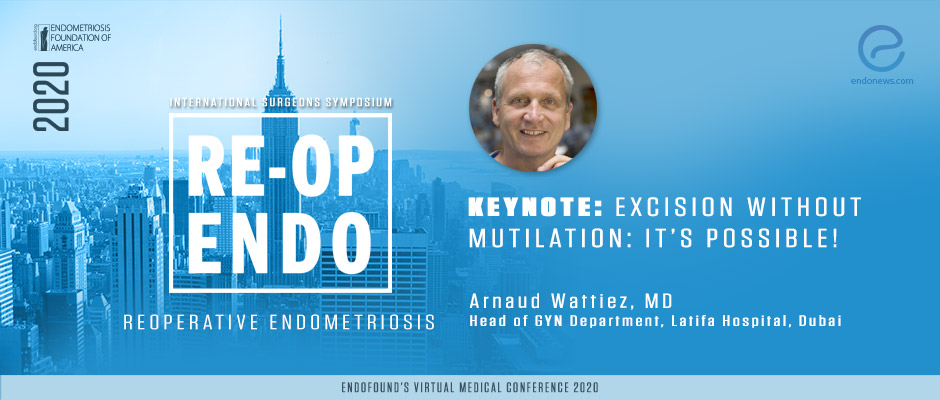KEYNOTE: Excision Without Mutilation: It’s Possible! - Arnaud Wattiez, MD
Jan 14, 2021
The objectives and requirements, such as fertility preservation of every individual patient should be taken into account when performing endometriosis surgery.
Key Points
Information about the presenter: This presentation is by Dr. Arnaud Wattiez, M.D., the Head of the Gynecology Department at Latifa Hospital in Dubai, UAE, the Head of Gynecological Endoscopy courses at IRCAD (Research Institute Against Digestive Cancer), Strasbourg, France, and a professor of OB/GYN at the University of Strasbourg, France. He is the keynote speaker at EndoFound’s 2020 virtual medical conference. His presentation is entitled: “Excision Without Mutilation: It’s Possible!”
Highlights:
- Endometriosis surgery and cancer surgery should be very different, with the former not necessarily having to be complete.
- Most endometriosis patients are young and their fertility should be considered.
- Endometriosis patients without symptoms should not be treated.
- The real progress in endometriosis treatment would be to move from sick-care to prevention through early diagnosis.
Importance:
- The objectives and requirements, such as fertility preservation of every individual patient should be taken into account when performing endometriosis surgery.
Remarks:
- Endometriosis has a considerable negative effect on patients’ well-being and quality of life.
- Surgery can be very effective in drastically reducing the pain that patients experience but it has to be tailored to the needs of individual patients.
- A proper endometriosis surgery requires a well-trained specialist.
- Endometriosis patients are usually young who likely require their fertility to be preserved.
- Partial surgery may be considered to preserve the patient’s fertility and the function of her pelvic organs.
- The concept of radical surgery should be replaced by that of economical surgery.
- Economical radicalism should be developed through better knowledge of the pelvic anatomy and of the disease.
- The concept of nerve-sparing surgery should be revisited to avoid unnecessary nerve dissection.
- Surgeons should work towards better disease management keeping in mind the patient’s objectives.
- A new subspecialty of pelvic endometriosis surgery should be developed to better address the patients’ problems.
Lay Summary
In his keynote lecture, Dr. Wattiez talks about the pros and cons of endometriosis surgery and the importance of tailoring endometriosis surgery to individual patients.
“Endometriosis is a disease that degrades patient’s wellbeing," Dr. Wattiez says and gives some examples of the disease’s negative impact on patients’ quality of life. According to Wattiez, 84% of women with endometriosis have a decrease in the quality of their work, one in five report being temporarily disabled, and 40% have their career growth negatively affected due to high rates of absence and/or low performance.
If done correctly, endometriosis surgery can drastically reduce disease symptoms, but there are many factors that have to be taken into account. Some of the drawbacks of endometriosis surgery include the risk of complications such as the development of adhesion, a reduction in ovarian reserve, a negative effect on pelvic organ function, and the risk of recurrence. “Surgery to treat endometriosis can sometimes cause more damage,” Dr. Wattiez says and stresses the importance of having a well-trained expert endometriosis specialist to perform the operation.
However, not performing surgery can also have great consequences such as pain centralization and the pain becoming chronic.
He describes the challenges that endometriosis surgeons face as follows:
- Should we operate on the patient at all?
- If so when and how should we operate her?
- How can we preserve her fertility?
- How can we preserve her pelvic organ function?
“We have to be radical but economical,” Dr. Wattiez says and he illustrates his point with two examples. In the first, he talks about nerve-sparing surgery where the decision lies between cutting a nerve and compromising function or leaving some disease behind. In the second, he talks about bowel endometriosis and the different surgical approaches that are used to treat it including shaving, disc resection, simple adhesiolysis, and segmental resection. Conservative approaches can preserve organs and nerves but may result in incomplete treatment while a more radical approach can remove all nodules but compromise function.
Then Dr. Wattiez describes the ways in which patients’ fertility can be preserved. These include partial surgery, economical surgery, egg or ovarian tissue freezing, embryo freezing, and in vitro maturation of immature follicles after the ovaries are removed. Dr. Wattiez concludes his lecture by touching on the many qualities a surgeon should have from knowledge, training, and ability, to creativity, imagination, and courage, and how these qualities should be used to meet the objectives of the patient.
Research Source: https://www.endofound.org/keynote-excision-without-mutilation-its-possible-arnaud-wattiez-md?pop=mc
endometriosis surgery ovarian reserve pain fertility mc2020

